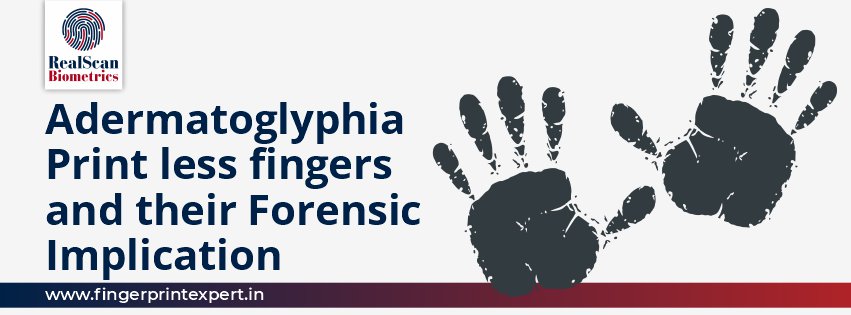The absence of ridges on the skin on the pads of the fingers and toes, as well as the palms of the hands and soles of the feet, is known as adermatoglyphia.
These ridge patterns (called dermatoglyphs) form whorls, arches, and loops, which are the foundation for each person's unique fingerprints.
Fingerprints have long been used to identify persons because no two people have the same patterns.
People with adermatoglyphia, on the other hand, lack these ridges, so their fingerprints cannot be used to identify them. Because affected individuals have had trouble entering nations that need fingerprints for identification, adermatoglyphia has been dubbed the "immigration delay disease".
Adermatoglyphia can arise in some families without any accompanying signs or symptoms.
In others, the absence of dermatoglyphs is linked to other characteristics, most commonly affecting the skin.
Milia, little white lumps on the face, blistering of the skin in places exposed to heat or friction, and a reduction in the number of sweat glands on the hands and feet are some of the symptoms.
Adermatoglyphia is also a hallmark of a number of uncommon ectodermal dysplasias, including Naegeli-Franceschetti-Jadassohn syndrome/dermatopathia pigmentosa reticularis, a disorder that affects the skin, hair, sweat glands, and teeth.
In 2007, dermatologist Peter Itin was contacted by a Swiss woman who was having difficulty entering the United States because she lacked fingerprints. All non-residents are required to have their fingerprints taken when they enter the nation, and police were perplexed when the woman said she didn't have any because she wasn't born with any.
When Itin investigated the issue further, he discovered that eight other members of the woman's extended family had similarly been born without prints.
Itin eventually tracked down three other unrelated families with adermatoglyphia, which they termed "immigration delay disease," and successfully found the single gene mutation responsible for this phenomenon.
Causes of Adermatoglyphia
Adermatoglyphia can be congenital or acquired. The isolated congenital adermatoglyphia and adermatoglyphia as part of a syndromic expression of congenital illnesses are both congenital causes. The isolated congenital form is believed to be an autosomal dominant disorder caused by a smarcad1 gene mutation.
Basan syndrome, naegeli-franceschetti-jadassohn syndrome, dermatopathia pigmentosa reticularis, reticulate acropigmentation of kitamura, and rothmund thomas syndrome are all congenital disorders caused by ectodermal dysplasias.
Basans Syndrome
Basans syndrome is an autosomal dominant ectodermal abnormality marked by congenital acral bullae that heal quickly, congenital milia, and a lack of fingerprints. Hypohidrosis, palmoplantar keratoderma, and nail dystrophy are some of the other symptoms of this illness. Basan syndrome is caused by a mutation in the smarcad1 gene, according to new research.
Naegeli-Franceschetti-Jadassohn Syndrome
Naegeli-franceschetti-jadassohn syndrome is an autosomal dominant form of ectodermal dysplasia characterised by reticular skin pigmentation, decreased sweat gland function, the absence of teeth, reduced palmar dermoglyphics, and hyperkeratosis of the palms and soles due to a keratin 14 mutation.
Dermatopathia Pigmentosa Reticularis
Dermatopathia pigmentosa reticularis is an autosomal dominant ectodermal dysplasia characterised by a triad of hyperpigmented reticulate skin, non-cicatrical alopecia, and onychodystrophy. Adermatoglyphia, thin, brittle nails, and a lack of sweat glands are also seen in patients. This condition is caused by a mutation in the keratin 14 protein
Kitamura's Reticulate Acropigmentation
Kitamura's reticulate acropigmentation is an autosomal dominant condition caused by mutations in the disintegrin and adam 10 genes. Linear palmar pits and pigmented macules 1 to 4 mm in diameter on the volar and dorsal parts of the hands and feet characterise this disorder.
Rothmund Thomas Syndrome
Rothmund thomas syndrome is an autosomal recessive poikiloderma characterised by scanty hair, eyelashes, and eyebrows, delayed growth, small stature, malformed teeth, nails, and gastrointestinal difficulties in childhood.
Forensic Implications of Adermatoglyphia
Adermatoglyphia and fingerprint changes can have major medical and legal consequences.
In such a situation, the medical physician's certification of the disease appears to be the best option for the patient to avoid any inconvenience.
At the same time, medical professionals and forensic experts must exercise caution, particularly in periods when criminals are known to modify their fingerprints in order to conceal their identities.
It's also worth keeping an eye on whether the loss of fingerprints is transient or permanent in these medical conditions.
In cases of adermatoglyphia, occupational disappearance of fingerprints (in the case of bricklayers and people whose job involves working with calcium oxide or lime), and intentionally alterations of fingerprints by any means (Harmon 2009), forensic practitioners must be extra vigilant and watch whether these alterations have gone deep beneath the skin and damaged the fingerprint ridges or is it a temporary damage where the fingerprints/ridges will readily emerge on the finger balls after few days of the momentary damage.
In circumstances when fingerprint identification is problematic or questioned, forensic scientists should rely on alternate means of identification such as facial recognition, iris or retinal scans.
In today's world, where fingerprints are used as a means of biometric identification in a variety of government and private organizations, such as aviation and immigration, office access, military, bank account operation, computer and mobile phone access, and so on, the loss of fingerprints could have serious consequences.

 January 24, 2022 - BY RealScan Biometrics
January 24, 2022 - BY RealScan Biometrics
